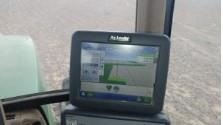By Stan Smith
Few can deny that year in and year out feed costs remain the single largest expense for a cow herd. In a typical year, feed costs can easily represent 50 to 70 percent of all costs in the operation with most of that expense being in the form of pasture or hay.

If precision fertilizer application is appropriate for corn fields, why not hay fields?
At the same time much has been said this winter about the extraordinary increases in the costs of production of corn, soybeans and most every crop we grow in Ohio. Accepting that, we realize likewise, the cost of maintaining, harvesting, and utilizing the basis of our beef cow ration – hay and pasture – are experiencing similar increases in cost. The question is, as we consider our alternatives are we treating those forages with the same respect as our row crops and carefully scrutinizing expenses and the management factors that can optimize the performance and productivity of our forages?
Let’s take a closer look at a few of those cost and management factors.
It starts with the seed
If we’re in a situation that calls for a new seeding or reseeding, very simply, do we put as much effort into selecting seed for the forage seeding as we have our corn and soybean seed? Much like with our traditional row crops, significant testing and research is involved in the development of forage seed genetics.
Do we have a fertilization plan for P and K?
I hope we agree we can’t manage what hasn’t been measured, and that includes soil fertility. If we grid or strategically sample our row crop fields, why wouldn’t that management strategy be just as important for a forage field?
It’s well known that a ton of forage removed from a hay field takes with it 12 pounds of P2O5 and 50 pounds of K2O. Are all areas of a hay field equally productive? If varying yields across a corn field result in P and K removal based on those varying yields, it stands to reason the same is happening in our hay fields. The most productive areas of any hay field are removing the most soil nutrients. To maintain soil fertility throughout the field those nutrients need to be replaced in the same quantities they were removed from throughout the field.
What about the pasture field? Accepting the fact most P and K remains on the field in the form of manure from the pastured animal, is our grazing management such that the manure is being spread uniformly? Are there any trees in the pasture? Where do our cattle relax in the heat of the day? I’m betting the fertility is much higher near a tree than anywhere else in the pasture! Considering the current cost of P and K, strategically soil testing pastures in sections or grids might yield some interesting results.
And, as we spread the fertilizer a soil test tells us is needed to optimize performance of our forages, do we utilize GPS guidance? I recall all the times back in the day I was sent out into the irregularly shaped hay field with the fertilizer spreader and the spread pattern looked like the Serpent mound by the time I ran out of fertilizer. I won’t discuss here if I ran out after covering the entire field . . . only once!
Are we strategically using nitrogen on grass pastures?
Strategically timing nitrogen application might mean foregoing an early spring application since it’s not uncommon to grow more first cutting hay or pasture than we can harvest in a timely fashion. However, 50 units of nitrogen applied to a grass hay or pasture field immediately after first or second cutting can significantly boost yield of the subsequent cutting.
Regardless if we’re growing corn or forage, applying nitrogen after a first cutting onto warm soils at times of high air temperatures increases the risk of volatilization of urea-based nitrogen sources. Do we use a stable source of nitrogen such as ammonium sulfate? If using urea and rainfall is not on the horizon, have we considered including a nitrogen stabilizer or urease inhibitor? If phosphorus is being applied at the same time, the nitrogen that comes along with a phosphorus source like 18-46-0 is stable and effective.
Do we have a pest – weed and/or insect – control strategy for hay or pasture fields?
It’s accepted that weeds hurt corn or soybean yields. I’d imagine that in a hay or pasture field every pound of weed produced likely results in one less pound of forage that can be utilized by livestock. Accepting that any plant in the wrong place is a weed, do we spend the same amount of effort controlling weeds in our forages as our row crops fields? Perhaps all that may be necessary is a strategically timed mowing of weeds or forage seed heads.
And, if we’re going to manage pest problems do we need to talk about the value in scouting for pests throughout the year? Do we need to be reminded about the invasion of the fall armyworm some of us experienced unexpectedly late last summer?
Is forage harvest, be it mechanical or by grazing, a carefully timed and managed process?
We plan to harvest no corn or soybeans before (or after) their time. I don’t think we need to go into detail here about the value in quality or tonnage of a timely forage or pasture harvest.
As we plan for 2022 are we treating our forages with the same respect as our corn fields? While there are no silver bullets for managing higher costs of production, perhaps it’s time for forages to command that same respect that our row crops do!
Source : osu.edu